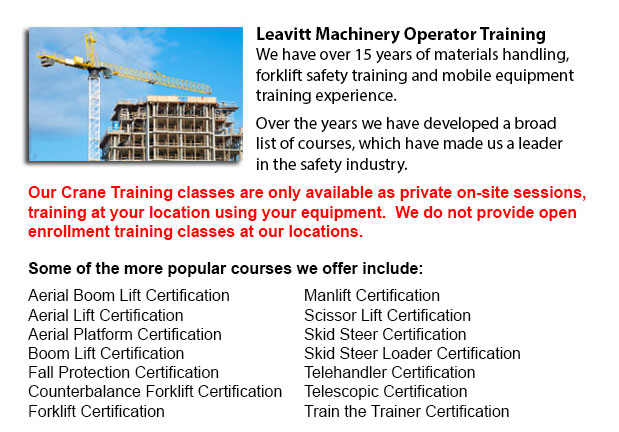
Crane Certification Grande Prairie - The Crane Certification training program consists of subject matter recommended by industry about the safe and efficient operation of cranes. People training will learn the following: how to identify cranes and their component parts; pre-operational, operational and post-operating requirements; rigging components and inspection/rejection criteria; how to determine overall lift capacity; and requirements particular to the work place where the individuals training will be operating.
Pre-operational requirements comprise assigning authority for the pre-operational check; performing the sequential pre-operational check based on the manufacturer's specifications or specifications certified by a professional engineer; inspecting the work place for hazards and obstacles; checking the log book for comments; checking hooks, chains, cables, crane movement and safety latches; ensuring the right functioning of operational controls; and knowing how to ensure the disconnect switch/isolator of the crane is properly working.
Operational requirements comprise identifying roles and responsibilities, and determining the need for a formal lift plan. People training will learn how to perform a danger assessment associated to environmental conditions, physical conditions and workers. Subject matter includes determining when to seek competent support, the safest route and destination of loads, and load weight and centre of gravity.
Trainees should be able to identify an over-capacity lift, in addition to be able to choose correct rigging machine, choose load limits, and to determine the safe site for the crane to operate from. Individuals training would review both universal and site-specific crane signals for lifts, and techniques for traveling, lifting and loading. Right maintenance habits will likewise be included.
The individuals training would undergo an examination to test their understanding of emergency response procedures for various situations, particularly electrical or mechanical failures. They would be asked to describe shut down and parking procedures for safety and security, to follow tagging and lock out procedures, and to explain why near misses are reported and recorded to the right individual. Log book records should be maintained.
People training would develop knowledge of rigging, in particular, establishing who has authority and responsibility for rigging, identifying various kinds of rigging, knowing load capacity ratings and storage procedures.
Post-operational requirements include entering deficiencies or defects, service and maintenance history in the log book, based on state, provincial and federal codes requirements.
What's more, we incorporate site-specific needs to be able to meet the employers requirements into our crane certification training program.
-
Forklift Operator Certification Grande Prairie
Forklift Operator Certification Grande Prairie - Certification for forklifts are needed to ensure the safe utilization of forklifts for those employers in industrial, warehouse or construction environments. The training has to involve a method of edu... More -
Skid Steer Ticket Grande Prairie
Skid Steer Ticket Grande Prairie - On a skid-steer loader, the lift arms are beside the driver along with pivot points behind the driver's shoulders. This makes them different as opposed to a conventional front loader. Due to the operator's proximity... More -
Order Picker License Grande Prairie
Order Picker License Grande Prairie - Order preparation operation or order picking as it is more usually known is a method utilized in warehouse operations and consists of staff referred to as order pickers. The order picker's job is to take and coll... More -
Telehandler Certification Grande Prairie
Telehandler Certification Grande Prairie - Telehandler certification programs are both for operators who have some experience driving a typical forklift and for people with no experience. The real-world training provided by these programs produces gr... More -
Skid Steer Loader Training in Grande Prairie
The engine powered skid-steer loader consists of a small and rigid frame, equipped with lift arms which could attach to numerous industrial attachments and tools in order to perform various labor saving tasks. Typically, skid-steer loaders are four-w... More -
Crane Training School Grande Prairie
Crane Training School Grande Prairie - The crane training school offers industry-relevant programs. Courses provide trainees with learning results that match current industry demands. Our small class sizes combine theory and hand-on experience. Our q... More -
Telehandler License Grande Prairie
Telehandler License Grande Prairie - The telescopic handler or telehandler is a commonly used machine in agricultural and industrial applications. This equipment is similar in look to a forklift and even works in a similar manner, even though telehan... More -
Aerial Boom Lift Ticket Grande Prairie
Aerial Boom Lift Ticket Grande Prairie - Aerial lifts can be utilized to accomplish several unique tasks executed in hard to reach aerial spaces. A few of the odd jobs associated with this kind of lift include performing daily maintenance on structur... More

Forklift Training Grande Prairie
TOLL FREE: 1-888-254-6157
11205-98 Avenue
Grande Prairie, Alberta
forklifttraininggrandeprairie.com
Email Us
About Us



